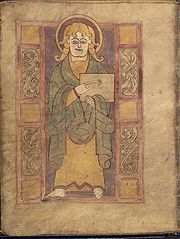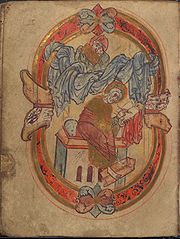
Gospel Book (British Library Add. MS. 40618)
Encyclopedia


Illuminated manuscript
An illuminated manuscript is a manuscript in which the text is supplemented by the addition of decoration, such as decorated initials, borders and miniature illustrations...
Irish Gospel Book
Gospel Book
The Gospel Book, Evangelion, or Book of the Gospels is a codex or bound volume containing one or more of the four Gospels of the Christian New Testament...
with 10th century Anglo-Saxon additions. The manuscript contains a portion of the Gospel of Matthew
Gospel of Matthew
The Gospel According to Matthew is one of the four canonical gospels, one of the three synoptic gospels, and the first book of the New Testament. It tells of the life, ministry, death, and resurrection of Jesus of Nazareth...
, the majority of the Gospel of Mark
Gospel of Mark
The Gospel According to Mark , commonly shortened to the Gospel of Mark or simply Mark, is the second book of the New Testament. This canonical account of the life of Jesus of Nazareth is one of the three synoptic gospels. It was thought to be an epitome, which accounts for its place as the second...
and the entirety of the Gospels of Luke
Gospel of Luke
The Gospel According to Luke , commonly shortened to the Gospel of Luke or simply Luke, is the third and longest of the four canonical Gospels. This synoptic gospel is an account of the life and ministry of Jesus of Nazareth. It details his story from the events of his birth to his Ascension.The...
and John
Gospel of John
The Gospel According to John , commonly referred to as the Gospel of John or simply John, and often referred to in New Testament scholarship as the Fourth Gospel, is an account of the public ministry of Jesus...
. There are three surviving Evangelist portrait
Evangelist portrait
Evangelist portraits are a specific type of miniature included in ancient and mediæval illuminated manuscript Gospel Books, and later in Bibles and other books, as well as other media. Each Gospel of the Four Evangelists, the books of Matthew, Mark, Luke, and John, may be prefaced by a portrait of...
s, one original and two 10th century replacements, along with 10th century decorated initials.
The manuscript has 66 surviving vellum
Vellum
Vellum is mammal skin prepared for writing or printing on, to produce single pages, scrolls, codices or books. It is generally smooth and durable, although there are great variations depending on preparation, the quality of the skin and the type of animal used...
folios. The pages are 130 by 105 mm. The text occupies an area of 101 by 73 mm. There are gatherings of 16 or 20 folios. The oak board used as the back cover survives along with a vellum cover from another book that was used as a wrapper starting in the 17th century.
The manuscript is missing several folios. The first 18 folios are missing from Matthew so the text begins at . There are two folios missing that contained the end of Matthew and the beginning of Mark. The remainder of Mark and the other two Gospels are complete. The original final page of John has been lost, but was replaced by a folio written in by a 10th century Anglo-Saxon
Anglo-Saxons
Anglo-Saxon is a term used by historians to designate the Germanic tribes who invaded and settled the south and east of Great Britain beginning in the early 5th century AD, and the period from their creation of the English nation to the Norman conquest. The Anglo-Saxon Era denotes the period of...
scribe. The original Evangelist portraits of Matthew, Mark and John have also been lost. In the 10th century Evangelist portraits were added to either replace or to supplement the originals. Of these the portraits of Luke and John survive.
The manuscript is a pocket gospel. The text belongs to the Irish Vulgate
Vulgate
The Vulgate is a late 4th-century Latin translation of the Bible. It was largely the work of St. Jerome, who was commissioned by Pope Damasus I in 382 to make a revision of the old Latin translations...
tradition with a few Old Latin
Vetus Latina
Vetus Latina is a collective name given to the Biblical texts in Latin that were translated before St Jerome's Vulgate Bible became the standard Bible for Latin-speaking Western Christians. The phrase Vetus Latina is Latin for Old Latin, and the Vetus Latina is sometimes known as the Old Latin Bible...
readings. The manuscript is written in a pointed Insular minuscule
Insular script
Insular script was a medieval script system originally used in Ireland, then Great Britain, that spread to continental Europe under the influence of Celtic Christianity. Irish missionaries also took the script to continental Europe, where they founded monasteries such as Bobbio. The scripts were...
in three hands, although the second hand wrote only a few lines on folio 51. Edward the Deacon, the scribe who wrote the Anglo-Saxon page at the end of John, wrote in an Anglo-Saxon minuscule that had some features of Carolingian minuscule
Carolingian minuscule
Carolingian or Caroline minuscule is a script developed as a writing standard in Europe so that the Roman alphabet could be easily recognized by the literate class from one region to another. It was used in Charlemagne's empire between approximately 800 and 1200...
. Edward added a colophon
Colophon (publishing)
In publishing, a colophon is either:* A brief description of publication or production notes relevant to the edition, in modern books usually located at the reverse of the title page, but can also sometimes be located at the end of the book, or...
in rustic capitals
Rustic capitals
Rustic capitals is an ancient Roman calligraphic script. As the term is negatively connotated supposing an opposition to the more 'civilized' form of the Roman square capitals Bernhard Bischoff prefers to call the script canonized capitals.Rustic capitals are similar to Roman square capitals, but...
(QUI LEGAT ORAT PRO SCRIPTORE EADVVARDO DIACONE – "may he who reads this pray for the scribe Edward the deacon").
The portrait of Luke, which is the only surviving original miniature, strongly resembles the Evangelist portraits of the Book of Mulling
Book of Mulling
The Book of Mulling or less commonly, Book of Moling , is an Irish pocket Gospel Book from the late 8th century. The text collection includes the four Gospels, a liturgical service which includes the "Apostles' Creed", and in the colophon, a supposed plan of St...
. The Anglo-Saxon miniatures are done in an early version of the Winchester Style and were influenced by Carolingian illumination. The manuscript originally contained decorated initials. These were erased in the 10th century and new zoomorphic initials were repainted in an Anglo-Saxon style. The placement of the initials is unusual because lines are rarely broken to start a new paragraph. The text usually continues and the initial is omitted from its proper place and is instead inserted into the margin. This system is used in some Greek manuscripts including the Codex Alexandrinus
Codex Alexandrinus
The Codex Alexandrinus is a 5th century manuscript of the Greek Bible,The Greek Bible in this context refers to the Bible used by Greek-speaking Christians who lived in Egypt and elsewhere during the early history of Christianity...
. There are gold crosses, which were probably also added in the 10th century, in the margins of John.
The manuscript is thought to have belonged to King Athelstan
Athelstan of England
Athelstan , called the Glorious, was the King of England from 924 or 925 to 939. He was the son of King Edward the Elder, grandson of Alfred the Great and nephew of Æthelflæd of Mercia...
, who may have ordered the 10th century "modernization". On folio 66 verso there is a partially erased 12th century inscription which reads "iste est liber sanct......" Also on folio 66v are two ownership inscriptions. One indicates that in 1538 the book was owned by William Newman. The other indicates that in 1662 it was owned by Robert Lancaster. The manuscript was purchased by the British Library
British Library
The British Library is the national library of the United Kingdom, and is the world's largest library in terms of total number of items. The library is a major research library, holding over 150 million items from every country in the world, in virtually all known languages and in many formats,...
at Sotheby's
Sotheby's
Sotheby's is the world's fourth oldest auction house in continuous operation.-History:The oldest auction house in operation is the Stockholms Auktionsverk founded in 1674, the second oldest is Göteborgs Auktionsverk founded in 1681 and third oldest being founded in 1731, all Swedish...
in 1922.
External links
Further reading
- New Palaeographical Society, Series II, plates 140, 141.
- Henry, F. "An Irish Manuscript in the British Museum." Journal of The Royal Society of Antiquaries of Ireland 87 (1957) pp. 147-166.
- Lowe, E.A. Codices latini antiquiores (Oxford, 1934-1971), vol. 2, no. 179.
- Alexander, J.J.G. Insular Manuscripts, 6th to the 9th century (Survey of Manuscripts Illuminated in the British Isles), (Harvey Miller: London, 1978), no.46.
- Temple, E. Anglo-Saxon Manuscripts 900-1066 (Survey of Manuscripts Illuminated in the British Isles), (Harvey Miller: London, 1976), no.15.
- Keynes, S. "King Athelstan's Books." Learning and Literature in Anglo-Saxon England, ed. M. Lapidge and H. Gneuss (Cambridge, 1985) pp. 143-201.
- McGurk, P. Gospel Books and Early Latin Manuscripts, Variorum Collected Studies (Aldershot, 1998) pp. I 250 and 261, II165-6 and 173-4, XII 14 and XIV 45.
- Gneuss, H. Handlist of Anglo-Saxon Manuscripts: A List of Manuscripts and Manuscript Fragments Written or Owned in England up to 1100 (Tempe, Arizona, 2001), no. 299.
- Brown, K.L. and R.J. Clark, ‘The Lindisfarne Gospels and two other 8th century Anglo-Saxon/Insular manuscripts: pigment identification by Raman microscopy.’ Journal of Raman Spectroscopy 35 (2004), pp.4-12.

